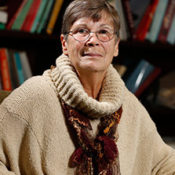******************************
Dr. Sara Eaton began her career as a Shakespearean scholar and early modernist at North Central College in 1989. Back then, the English Department referred to the basement of Oesterle Library as its unceremonious home, one reminiscent of an aging church basement – old carpet sutured together by duct tape that peeled at the corners, tacky orange furniture that bled into the walls and a distinct mildew smell that stuck in the nose.
Parker Eaton – Sara Eaton’s husband – helped her move box upon box of books and research into a cramped communal office space, one which rotated among the other members of the faculty in an office version of “musical chairs.” Yet, it was in this space she first met many lifetime friends and colleagues who she would know for the next 27 years – Dr. Richard Guzman, Dr. Francine Navakas, Dr. John Shindler, who witnessed her pass for the fifth or sixth time with another heavy box and place it on her joint desk.
“Can I help you?” he asked.
Her brow furrowed into a sidelong glance and the corner of her mouth lifted into a subtle smirk, creating a half-deadpan, half-playful expression; there was mischief in the eye: “Your timing is impeccable,” she said. There were no more boxes left to carry.
Humor and wit became Sara Eaton trademarks among faculty members. As a feminist and Shakespearean scholar, Eaton utilized humor as a vessel through which she communicated ideas as well as the hand she dealt in the wider academic game. “Cutting through the crap” she called it – a motto she valued both in teaching and in life.
Years after his first meeting with Eaton, Shindler would ask her to visit his critical methods course, in which he witnessed a particularly obstinate student. “What’s the point?” she would ask in response to Saussure and Derrida and Neitzsche. “What’s the theme?” Fifty minutes into Eaton’s presentation, her objections were no less relenting: “So what’s this play actually about?” she asked. “What’s the theme?”
Eaton inhaled steadily as an all-too-familiar expression creeped into the contours of her face. “Well, it’s a Friday afternoon,” she said, “so I can do this…”
Her hand moved swiftly and confidently over the chalkboard: “Shit happens,” she wrote.
The looks of shock and unease on her students’ faces delighted and thrilled her. No one dared speak, save for Eaton. She laughed.
******************************
During the interludes of a life embodied by language, laughter and wit, Sara Eaton’s life was also filled with peace and contemplation. For more than half her life, Eaton smoked. It was the single vice of a feminist self-consciously concerned with health and fitness as a woman. Though it was equally a necessity – an excuse to escape to the uninhabited corners of Kiekhoefer Hall and meditate in those rare moments of silence and solitude. She quit, suddenly, in 2012 when her back pain led to a necessary spinal fusion. When her doctor warned her that her continued smoking would interfere with the fusion healing process of her back, she kicked the long-forming habit quickly.
Eaton’s doctor recommended walking as part of her post-surgery regime. On Mondays and Wednesdays, she would be accompanied by her friend and colleague Dr. Sohinee Roy, and occasionally her dear friend Dr. Lisa Long, for bi-weekly walks throughout Naperville. The two always followed the same familiar path: south down Brainard Street past Chicago Avenue, left on Julian, and another left at School until reaching Kiekhoefer at the intersection of Loomis and School. Like nicotine, the walks became addictive, habitual and mandatory; they provided a new outlet for self-reflection and meditation in the absence of smoke breaks. For Eaton, they were a means of exercise and mental and physical health; for Roy, a junior faculty member, they were invaluable chances to engage with and learn from a highly admired mentor.
 Though Midwestern bred, Eaton hated the cold. “I find the cold unbearable,” she would say more than once each winter. Regardless, neither Eaton nor Roy skipped their bi-weekly walks for any reason during the school year – not for exhaustion nor lack of time nor the biting Illinois cold. During the infamous Polar Vortexes of 2014, both Eaton and Roy braced high winds and blinding blizzards for the chance of each other’s company and a momentary mental break. Eaton would wear her signature winter look: thick black tights beneath a long beige skirt – a trade Minnesotan secret to maintaining maximum warmth – and her favorite brown boots – the ones with the renewed soles, though she had bought a brand-new pair of boots she never wore or refused to wear. On top, she donned a recognizable cream batwing sweater with a maroon scarf looped around the turtleneck. After divulging her secret to Roy, she would try it too and agree it was effective. Neither ever caught cold during those winters.
Though Midwestern bred, Eaton hated the cold. “I find the cold unbearable,” she would say more than once each winter. Regardless, neither Eaton nor Roy skipped their bi-weekly walks for any reason during the school year – not for exhaustion nor lack of time nor the biting Illinois cold. During the infamous Polar Vortexes of 2014, both Eaton and Roy braced high winds and blinding blizzards for the chance of each other’s company and a momentary mental break. Eaton would wear her signature winter look: thick black tights beneath a long beige skirt – a trade Minnesotan secret to maintaining maximum warmth – and her favorite brown boots – the ones with the renewed soles, though she had bought a brand-new pair of boots she never wore or refused to wear. On top, she donned a recognizable cream batwing sweater with a maroon scarf looped around the turtleneck. After divulging her secret to Roy, she would try it too and agree it was effective. Neither ever caught cold during those winters.
During their walks, Roy would witness a less-academic though equally intelligent side of Eaton. These conversations ranged from politics to fashion – Eaton had a penchant for dark colors and manicured nails – to food and baking to family and frustrations about work. Passing the backyard flower beds and communal gardens on Julian, they would discuss Eaton’s own garden of daylilies – her favorite. Living in deep suburban Illinois, her daylilies became a puckish refuge from the endless mazes of cornfields and farm fields.
Passing the residencies on Julian, Eaton and Roy would tease and imagine purchasing one of the homes to share. One caught Eaton’s eye at the corner of Julian and School – a Tudor home peppered by trees and flowers selling for $2 million, conveniently located a mere five minutes from her workplace, as if by fate. “We should pull our resources together and buy it,” Eaton would wink at her, half-joking, half-serious. And she would laugh.
“It was the most wonderful sound,” said Roy.
******************************
Eaton retired in the spring of 2016 after more than two decades of teaching and service. As custom, the English faculty held a farewell ceremony in honor of their beloved mentor and friend. During the ceremony, Eaton glanced around the room at her colleagues, her face faintly crinkled in introspection.
“I was thinking,” she stated aloud. “I realized, save for two or three, I hired all of you.” She smiled, puckishly. “You’re mine.”
It was a compliment to her staff as much as a testament to her success as an educator and scholar, witnessed in that mischievous smile. Her humor and wit, her insightfulness and ingenuity were imbedded not only in her students but in the colleagues who observed this through the intimacy of her friendship – in her office space, in the classroom, in the daylily gardens on Julian.



2 Comments
Great story! So insightful and personal.
Thank you for this article, so worthy of its subject. As a former advisee of Sara’s, I can still hear that laugh.